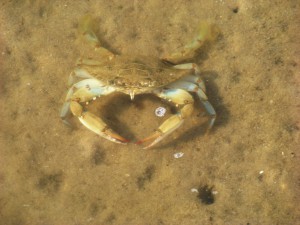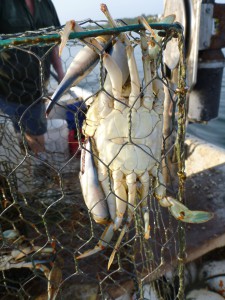Well… we have talked about the “big two”… snapper and shrimp, but there are other popular fin and shellfish harvested from the Gulf of Mexico. This week we look at my personal favorite… blue crab.
Probably like many of you out there, the very first sea creature I ever caught was a blue crab. It was with one of those classic basket traps where you baited it, lowered to the bottom where you could see, waited until a crab came for the bait, and pulled her in… GREAT fun. My parents cooked the crab, saved the shell and dated it. It sat on the cabinet above our breakfast bar for years. It was something I did every summer off the dock of the house we rented on Pensacola Beach… good times.
As I got older we switched from crab traps to hand-held crab nets. We would spend hours searching the grass beds around Gulf Breeze collecting and cleaning these guys. I remember cleaning over 60 of them once until my hands bled, that was about the time I thought I would let the commercial guys do this and I would just buy it from them!
As much fun as I had catching them, I had just as much fun cooking. My wife and I would make deviled crab and one of my personal favorites of hers, crab meat baked on an English muffin with cheese. Man o’ man. What a great creature the crab.
There are about 4500 species of “true crabs” found on our planet and many are valuable as a seafood product. In the Florida Panhandle it is the Blue Crab most seek out. In recent years commercial and recreational crabbers have noticed a decline in their numbers. Landings of blue crab ranged between 8 and 12 million pounds in Florida from 1982-1999 and since 2000 the landings have ranged from 4 to 8 million pounds. Researchers with the Florida Fish and Wildlife Conservation Commission have run several models to determine why the decline in landings has occurred. Though the decline in the Chesapeake may be due to overfishing, the models do not suggest this for Florida. They are not sure why the decline has happened but do have data that support the argument that freshwater discharge during heavy rain events does impact their population in a negative way. Some data suggest the increase in salinity during drought conditions has done the same. Whatever the reason, many would like to see their numbers rebound to the 12 million lb. landings we had just a few years ago.
Blue crabs typically live to be 1-2 years old, though some have been aged to 5 years. Males prefer the less saline waters of the upper estuary and the females can be found throughout the bay. Males reproduce more than once in their lives providing the females with a sack of sperm called a spermatophore. Females mate only once, just after their last molt. Once she has received the spermatophore she heads for the mouth of the bay where the water is more saline, she may enter the Gulf of Mexico searching for the right habitat. When she fertilizers her eggs they remain with her as a mass on her underside; the egg mass resembles a sponge. The larva hatch from this mass and go through several development stages as they re-enter the estuary and begin the cycle again.
Whatever the reason for their decline, and recent increase in price, these crustaceans remain a Gulf coast favorite and I for one hope they remain around for a long time.
- Our Environment: Part 11 – We Need Water - July 7, 2025
- Our Environment: Part 10 – Improving Agriculture - June 20, 2025
- Marine Creatures of the Northern Gulf – Snails and Slugs - June 20, 2025


